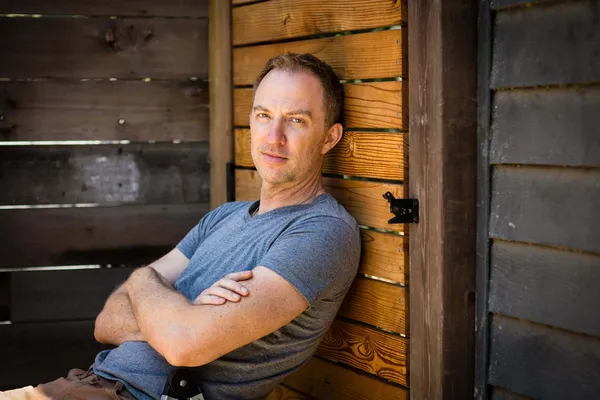 |
| Lasso director Evan Cecil |
Whips, branding, cages, angry animals - the horror potential of rodeo is such that it's curious how it has been overlooked. Evan Cecil's new film, which follows what happens at a sinister rodeo after hours, has great fun with all these things and is bound to get the audience excited when it screens at Frightfest this week. Called Lasso, it's film that knows its horror tropes but also throws in a few wild cards.
Evan has mostly been working in television in recent years, on series like Wives With Knives and Sex Sent Me To The Slammer. I asked him why he felt that now was the time to take the plunge and direct a feature.
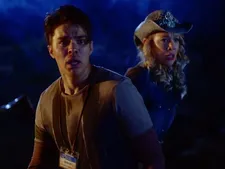 |
| Facing danger Photo: Epic Pictures Group |
“The opportunity presented itself!” he says. “It sort of just fell in my lap... One of the local California Bay Area actors [Todd Myers, who went on to become executive producer of Lasso and plays a character called Brando, with a branding iron] watched me work and the team I work with work, and he felt that we were really good at what we did and that he wanted to make a movie with us. From there, I just happened to have this idea of a horror movie set in a rodeo that had been bouncing around in my head for years and it was just one of the ideas that came on the table so we moved forward with that.”
How did it develop from there? Did he come up with the various uses of rodeo equipment himself, or was it a collaborative experience?
“There were some things that had maybe been bouncing around in my head for years, but a lot of it was worked out with the writer [Roberto Marinas]. We hired a writer because I’d got somewhat of a story but not really enough, so me and the writer worked together very closely until the story was very complete and then he built a script. So I would say that a lot of it came out in the story building. You know, all of the weird kills, stuff like that.”
The film is carefully structured with lots of small asides that prove to be important later on, but one part of it where that can't really be done is in the arena footage of the rodeo itself. How did he approach capturing that so that it could be edited together to look convincing and tell the story he wanted?
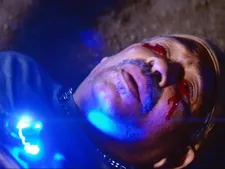 |
| On the wrong end of a cattle prod Photo: Epic Pictures Group |
“I’m happy to hear you say that you were convinced!” he laughs. “There were elements of the story that got cut down and some of it was the daytime radio stuff... One things that was really great was that the rodeo arena where we filmed it, they let us come back a month or two later when real rodeo was going on and we got some great footage. We were able to walk all over the place and film the real rodeo going on. It was a great perk of that location.”
How did he find that location?
“We looked around. The main thing that we really wanted or that I wanted – was that the rodeo be more in the woods rather than out in the open plain that you think of for a Westerny vibe. It was actually quite tricky to find one – it was very hard to find one that was not right next to a freeway, which would have spoiled the whole atmosphere of the thing. That was a big factor in choosing this one. There were also great hosts, you know? They were excited to have us there.”
So they were comfortable with the idea of rodeo horror?
“Yeah, they were! It was funny. There were a few times that we had bloody things, and – we were often there all night and they weren’t there at night so we would have to leave signs to say ‘Sorry there’s all this blood all over this area of the arena,’ but, you know, we needed to do it and they thought that was funny. They were great about it.”
It must have been tough shooting so much of the film in low light.
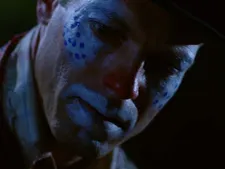 |
| Clowning around Photo: Epic Pictures Group |
“It was gruelling. It was exhausting, you know? We had less than 25 days to shoot and twenty-something days of that was full night. We had a Sony camera which is a really nice camera but it’s not uber popular so Sony was really excited for us to use it... Luke [Sauer], our DP, said ‘Lets’s use this camera. It’s an amazing camera and one thing that it does really well is shoot in low light.’ I think he made the right choice. I think it looks great. I’m happy.”
There must also have been challenges in lighting the special effects, too.
“Yeah. it’s true. If you take most special effects and you look at them in bright light, they look not that great, so you definitely have to light them right to make them convincing. And we did probably a little more nuancing in post on top of the practical effects than maybe we could have done.”
Something else that stands out in the film is its use of elderly characters, who are rare in the genre. Did he bring them into the story because he was interested in the possibilities for character development or because he wanted to explore the potential of something that hadn’t been done much before?
“I think both. I mean, I feel like that’s the thing with horror, is there’s few things that haven’t been seen before. I think that’s so important with horror because there are so many things where you see it all the time. And I think older people are usually a bit scary in horror movies so I thought it was a cool idea to make them more heroic and have more character.
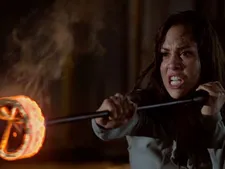 |
| Branding time Photo: Epic Pictures Group |
“It’s sort of a little bit inspired by my mom. My mom is a very active older woman and she doesn’t actually go to a group [like the older characters in the film] but it’s a little bit of a challenge for her to find peers that can keep up with her. She likes to hike and go in the outdoors and stuff like that.”
It’s nice to see older characters who are not just victims all the time, I say, and he agrees.
We talk about Frightfest and his excitement about the film screening there, and I ask if it has been screened at other festivals. Not much, he says but a little bit.
“We screened it at the Oakland Film Festival. I live in Oakland, California so we showed it there recently and that was really fun. It was a nice balance of a lot of friends who are local, a lot of crew members who are local, but then it was also open to the public so it was fun to see how people reacted to it. It was good, it was exciting.”
Next up for Even is a film called Bunker, written by Travis Andre Ross, who stars in Lasso. I ask if he’s at liberty to talk about it.
“Yeah,” he says. “Bunker is another indie film, kind of a single location film – we’re going to do it in a single shot style, actually. And it’s basically a military operation that the rally point after this mission is this bunker and the mission goes really terrible and so it’s these troops all trickling into this bunker and having to figure out what happened, and they slowly realise that it’s someone within the group, so it’s got a little bit of a mystery to it.”





















